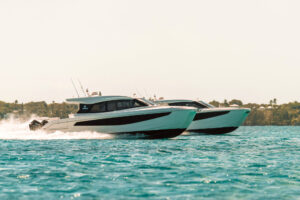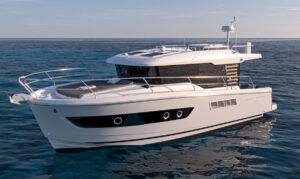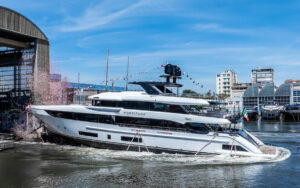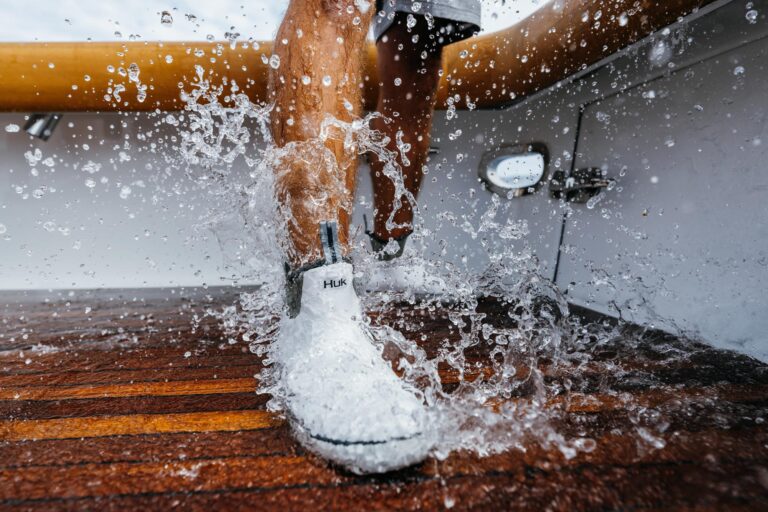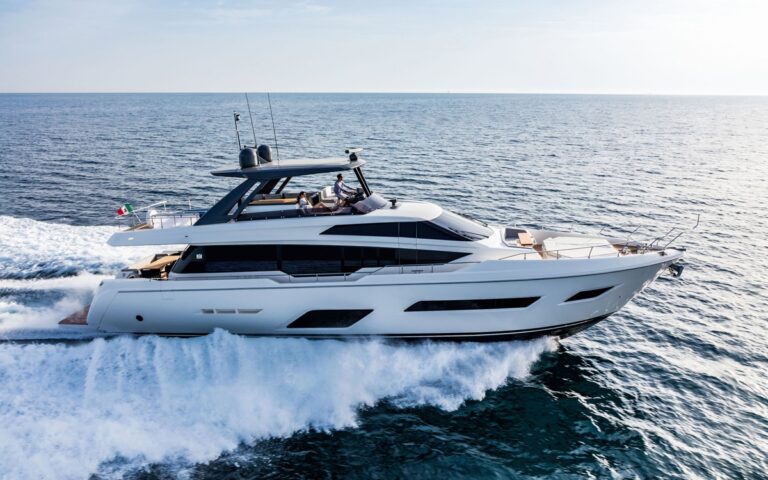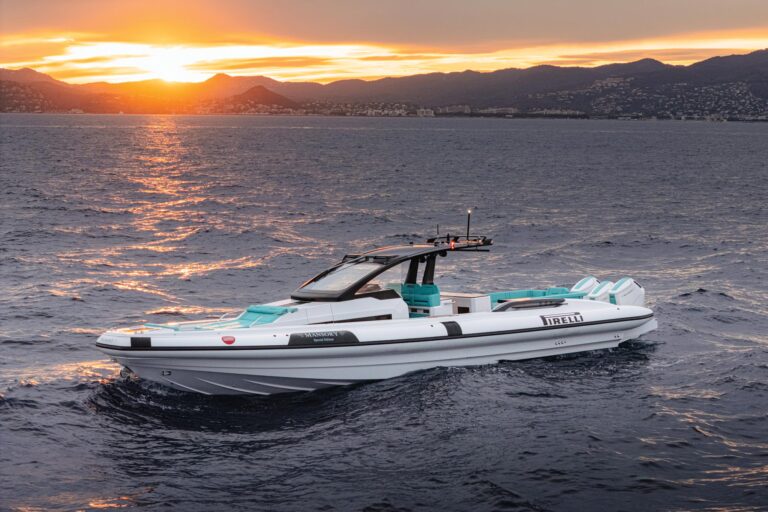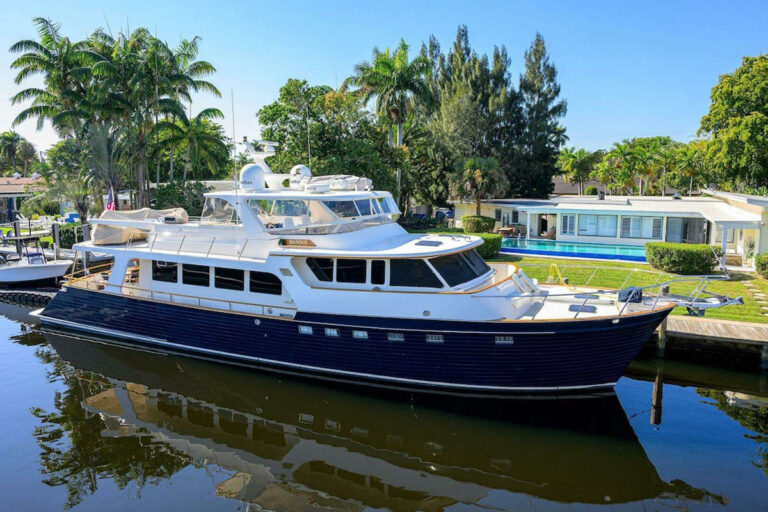
The Tom Fexas-Designed planing hull tames the waves with double chines.
There are few yacht builders in the world that can claim as broad a base of experience as Cheoy Lee Shipyards. From sloops to sportfishing boats the builder has had a hand in almost every niche of the yacht market. This flexibility and Cheoy Lee’s focus on innovation and value have given the brand an enviable reputation, of which this latest, the 84-foot Sport Motoryacht, is a prime example.
In a sense, the 84 began life in the mid-1980s when Cheoy Lee approached yacht designer Tom Fexas with an offer to assist in producing a series of motoryachts from 83 to 92 feet. At the time, few builders saw a future for fiberglass in larger, high-speed yachts, as solid fiberglass laminates could not compete in terms of weight with aluminum. Cheoy Lee and Fexas had already helped pioneer the use of “sandwich construction” with closed-cell foam in a fleet of smaller production boats; now they would trailblaze the weight-saving technology on a larger scale. “It was a challenge,” recalls Fexas, “as there was little empirical engineering data available at the time.”
The gamble paid off as, with a pair of 900 hp Caterpillars and a cruising speed of 20 knots, the 83 was more than competitive with the aluminum designs that dominated the market at the time. Much has changed in the past 20 years in terms of horsepower and performance, yet the 83’s hull form still makes sense. In fact, in my opinion it is one of the best in Fexas’ portfolio. “It’s a planing hull and was designed for seakeeping and efficiency at high speeds,” says Fexas.
Relatively deep sections forward that tame head seas go with slippery after sections, with 11 degrees of deadrise at the transom. Fexas’ trademark double-chine design helps trim wetted surface aft while a moderate keel provides directional stability. Although Fexas frowns on fitting stabilizers on fast, hard-chined designs, they are a popular feature and are standard on the 84-as is a bow thruster. Cheoy Lee’s data reveal that the standard pair of 1,550 hp Caterpillars delivers a maximum speed of approximately 28 knots and a cruising speed of 22 to 24 knots.
“Most of the folks looking at boats in this class intend to carry a professional crew,” says Bob Reneau, marketing manager for Cheoy Lee North America. An 81-footer introduced by Cheoy Lee in 1997, very similar to the 84, lacked adequate quarters for the crew-but, says Reneau, “The 84’s additional length allowed us to add separate crew quarters for two aft and extend the afterdeck and the boat deck.” Side decks allow the crew to move about the boat without disturbing the owner’s party.
Owner and guests board astern. The afterdeck has a built-in seating area, a wet bar and stairs that lead below to the swim platform and above to the exterior bridge deck. A sliding glass door leads to the main saloon where there is a full-service wet bar and a formal dining area. The galley, a lounge area and the helm station are forward. Hull number one’s owner opted for a simple interior helm arrangement with no helm seat and jog-lever-style steering.
Spiral stairs amidships lead above and belowdecks. The teak-soled exterior bridge area has a full control station with helm and companion seating. An L-shaped lounge has a full-service wet bar that can be enhanced by a grill. As there is plenty of space, the optional hot tub is worthy of consideration. The boat deck can take a 15-foot tender as well as a personal watercraft. A fiberglass hardtop is integrated with the rakish arch design and Strataglass can be fitted. A fully enclosed bridge option is also offered; this would be a must if the interior helm is omitted. Engine controls with a remote plug-and-play feature or wing stations are a desirable option.
Belowdecks, the full-beam owner’s stateroom has a king-size berth, a walk-in closet and a head with a whirlpool bath and a separate shower. A guest stateroom to port has a queen-size berth; one to starboard has two single berths. Both have private heads. Stairs adjacent to the interior helm lead forward to a VIP stateroom with a queen-size berth and a private head.
While Cheoy Lee refers to hull number one’s high-gloss mahogany interior finish and four-stateroom layout as the standard, Reneau suggests that the yard takes a semi-custom approach: “We work to satisfy our clients’ needs on the drawing board before we start construction.” With a degree in mechanical engineering and a resume that includes skippering yachts up to 120 feet, Reneau is a valuable resource. “There is no reason any two 84s have to be the same,” he says.
Cheoy Lee was founded in Mainland China more than a century ago and moved to Hong Kong in 1936. The yard’s migration into recreational boating began in the 1950s with a series of wooden sailing and trawler yachts. Fiberglass yacht offerings followed, while at the same time Cheoy Lee built its commercial and military business. Unable to expand and improve its facilities in Hong Kong, the company, including most of its craftsmen, moved back to the mainland in 2000. Cheoy Lee’s new state-of-the-art shipyard, located on the Pearl River at Doumen, is just 60 miles from Hong Kong. More than 800 craftsmen work in fiberglass, steel and aluminum, with the bulk of their efforts dedicated to the construction of commercial vessels up to 65 meters. Seven of the eight brothers that are responsible for the operation of the company are engineers and their innovative spirit is evident in the 84.
Unlike Cheoy Lee’s early fiberglass vessels, which were laid-up by hand, most fiberglass parts created at the yard are now made using a resin-infusion process. Stitched and woven reinforcements are carefully arranged in the mold. The dry laminate is then sealed and a vacuum is drawn. Resin is introduced and migrates through the lay-up. “In the past, hand lamination was performed by relatively unskilled labor,” says Reneau. “Today one of the brothers manages the infusion process personally.” A variety of foam materials are used, each chosen for its suitability for the particular application.
The 84’s hull is cored above and below the waterline and is supported by a fiberglass stinger system and foam-cored bulkheads. Portions of the interior are also cored with foam including trim work and moldings, which are built of lightweight infused parts covered with wood veneer. Exterior surfaces are finished with Awlcraft 2000; the bottom has a vinylester skin coat and epoxy barrier coat.
Engineroom access is through the crew’s quarters via the swim platform or the afterdeck. An emergency exit leads forward to the accommodation space. The 84’s well-organized machinery layout and tidy systems have trickled down from Cheoy Lee’s commercial work. For example, the fire-extinguishing system includes ventilation dampers on the air plenums that close automatically when the system is actuated.
Priced at $3,196,500, the 84 includes what is in essence a have-it-your-way interior layout, including soft goods. Add electronics, tender and most of the options and you are under way for about $3,500,000. If you are familiar with Cheoy Lee’s new products-and especially if you are a fan of Tom Fexas’ designs-you’ll likely find this prospect very appealing.
Contact: Cheoy Lee Shipyards North America, (954) 527-0999; www.cheoyleena.com.
Creative Alternatives
While Cheoy Lee has worked with many well-known designers over the years, Tom Fexas’ contribution has in many ways defined the builder’s role. Cheoy Lee has always offered a creative alternative to the mainstream. Whether it was the avant-garde styling of the builder’s line of sportfishing boats circa 1980, from which details are still “borrowed” today, or performance gains made possible by the application of lightweight sandwich construction, Fexas has always delivered.
Born in Beechhurst, New York, in 1941, Fexas was fussing about in boats before he had crawled out of his crib. “I was born in January and was cruising aboard my dad’s 3l-foot Wheeler in May,” says Fexas. He received a degree in marine engineering from the New York State Maritime College and served at sea on the passenger ship Independence. He later served at the drawing board at Electric Boat Company in Groton, Connecticut. He began the Westlawn course in yacht design while at sea and finished it after coming ashore. “I landed my first commission, a 50-foot trawler, while still designing submarines,” says Fexas.
Next stop: paradise. “I gave up my real job to move to Florida and build the boat I had dreamed of since I was a kid.” Fexas penned the Midnight Lace in 1977 and few would argue with the statement that it is his signature design: sleek, lean, fast and efficient.
Although the first Cheoy Lee 44 was built in Florida, the production models that followed were built at their facility in Hong Kong. Impressed with Fexas’ innovative nature, Cheoy Lee promoted the relationship and more than 25 production designs from 38 to 92 feet followed. “Cheoy Lee deserves credit for its understanding and willingness to apply new technologies,” says Fexas. “They were one of the first production builders to embrace core materials, integral fiberglass tanks and underwater exhaust.”

